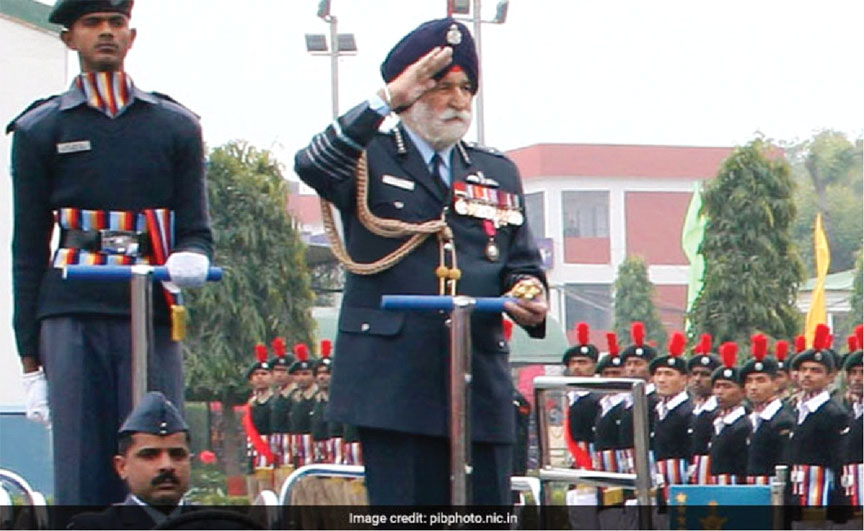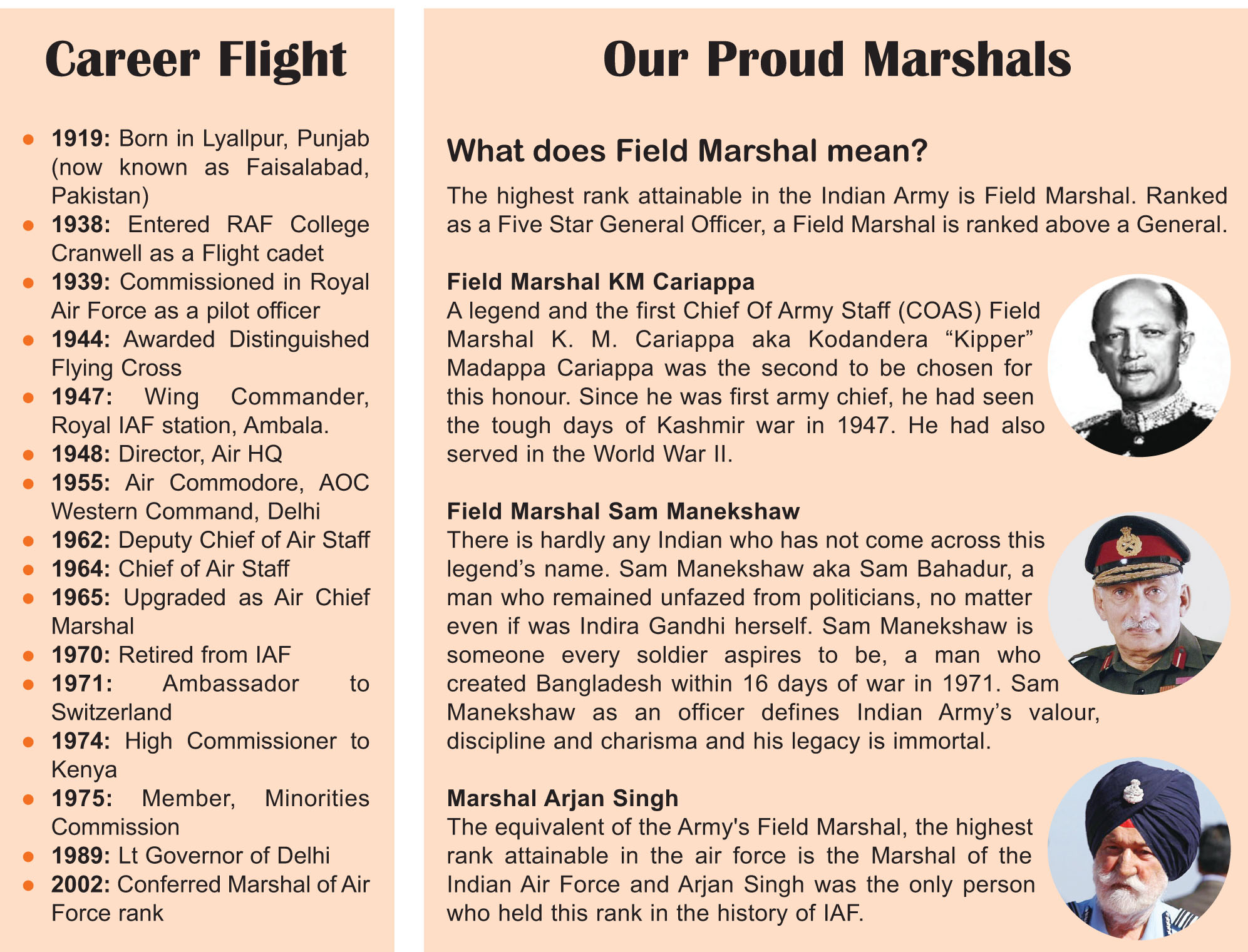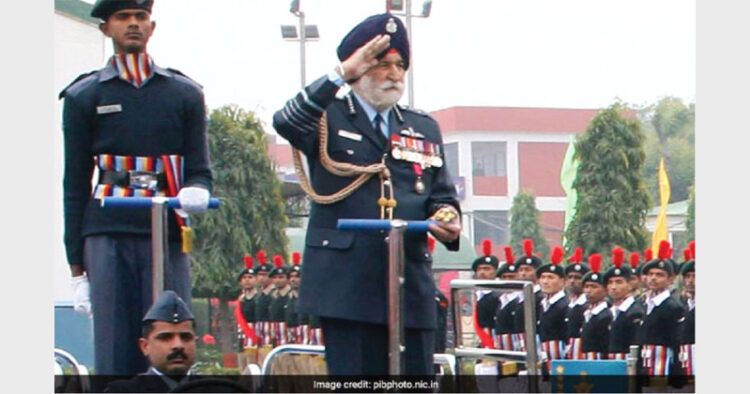 Taking off from Lyallpur it has been an exceptional career flight of Marshal Arjan Singh, who won laurels in the 1965 Indo-Pak War
Taking off from Lyallpur it has been an exceptional career flight of Marshal Arjan Singh, who won laurels in the 1965 Indo-Pak War
Ajay Bhardwaj
In the death of Marshal Arjan Singh, 98, a glorious era of the Indian Air Force came to an end. The only IAF officer to have been conferred the rank of the “Marshal of the Indian Air Force”, Arjan Singh was also the first IAF officer to have been ranked Air Chief Marshal after he had displayed exemplary leadership to neutralise Pakistan”s air offensive in the 1965 war when he was just 46. In the most trying period of the Indian Air Force he led the force with elan for five years as the IAF chief between 1964 and 1969.
 Born on April 15, 1919, in Lyallpur (Pakistan) he had his education in Montgomery before getting selected for the Empire Pilot training course at RAF Cranwell in 1938 at a small age of 19 years. His first posting on being commissioned involved flying Westland Wapiti biplanes in the North Western Frontier Province as a member of the No. 1 IAF Squadron.
Born on April 15, 1919, in Lyallpur (Pakistan) he had his education in Montgomery before getting selected for the Empire Pilot training course at RAF Cranwell in 1938 at a small age of 19 years. His first posting on being commissioned involved flying Westland Wapiti biplanes in the North Western Frontier Province as a member of the No. 1 IAF Squadron.
The Indian Air Force’s only Field Marshal has inspired generations of flyers ever since he joined the IAF in 1939 and was posted to IAF’s Number 1 squadron at Ambala in January 1940, flying in frail Westland Wapitis. In 1945 he was awarded Distinguished Flying Cross for his absolute dedication and commitment. Arjan Singh is also remembered for his operational distinction on the Burma Front during World War II. After the Partition, he became the first commander of the Air Force station in Ambala. On August 15, 1947, he led a fly past over the Red fort in Delhi.
Cover Story/Marshal Arjan?Singh : THE MOST LOVED Leader
 In his career, Arjan Singh had flown more than 60 types of aircraft ranging from pre-World War II era biplanes to Gnats and Vampires.
In his career, Arjan Singh had flown more than 60 types of aircraft ranging from pre-World War II era biplanes to Gnats and Vampires.
His zest for flying didn”t end until the day he retired in 1969. When he was Chief of Air Staff, the IAF acquired supersonic fighters, strategic reconnaissance aircraft, tactical transport aircraft and assault helicopters, many of which are still in service today.
Padma Vibhushan
After his oustanding services in the 1965 Indo-Pak war his post was not only elevated to that of the Air Chief Marshal, but he was also awarded Padma Vibhushan.
This is leadership from the front, which the IAF has seen right from the time he joined it in 1939, the gallantry in the Imphal campaign of 1944 and the conflict of 1965. It is unprecedented and completely selfless, which is what his actions have been throughout, recalls a senior IAF officer.
After his superannuation in 1969 life stilll kept on moving in a distinguished manner as he was appointed Ambassador to Switzerland in 1971 and later High Commissioner to Kenya in 1974. In the late eighties, he also had a stint as Lt Governor of Delhi.
According to the IAF’s official website, Singh’s “testing time came in September 1965, when the subcontinent was plunged into war. When Pakistan launched its Operation Grand Slam, in which an armoured thrust targeted the vital town of Akhnur, he was summoned into the Defence Minister’s office with a request for air support.”
“With a characteristic non-chalance, he replied ‘…in an hour.’ And true enough, the air force struck the Pakistani offensive in an hour. He led the air force through the war showing successful leadership and effort.” He was also of the opinion that the IAF should have been used in the 1962 India-China war.
Marshal Philanthropist
In 2002 when he was conferred the title of Marshal, he joined the prestigious ranks of Field Marshals S.H.F.J. Manekshaw and K.M. Cariappa and became the only IAF officer to become Marshal in the country .
In a glorious gesture of welfare towards his fellow IAF colleagues, he sold off the only piece of land he had owned near Delhi in 2004. He earned Rs 2 crore and formed a trust for this purpose.
The farm that MIAF Arjan Singh sold was the last link he had with land, which was very dear to him. His grandfather, Risaldar-Major Bhagwan Singh, had a farm near Lyallpur, now called Faislabad, in Pakistan, where the young Arjan Singh spent his childhood, watching planes and dreaming of flying one, someday.
In an interview he said that after Partition, the family was allotted 80 acres of land in Churwali village, near Adampur, Punjab. “I was also allotted a pucca house. Kartar Singh, a good man, used to look after the land and when I sold it, I gave the house to him. I sold off the land because I could not take care of it as I was in service. In fact, when I told Sardar Swaran Singh (the then External Affairs Minister), in whose constituency my land fell, how much I had sold it for, he chided me for selling it below the market rate,” he said. “I am no longer a Jat as you said in the book, I have no land now,” said Arjan Singh, recalling a comment made in the book.
Just minutes before the final rites, a 17-gun salute was accorded. It was followed by a flight of three Mi17 V5 copters flying with flags of the country and the IAF under-slung. A formation of Sukhoi-30 MKI fighter jets gave the final salute, in what is called ‘missing man formation’ for Marshal Arjan Singh’s ‘final flight’. The ‘missing man formation flying’ is marked to signify the loss of fallen comrade. It reserved as high honour in the IAF.














Comments